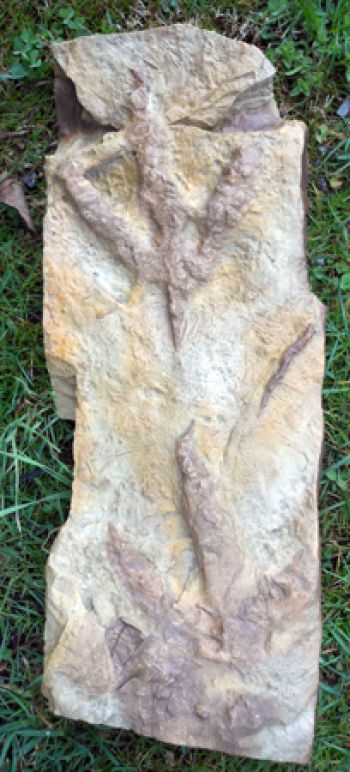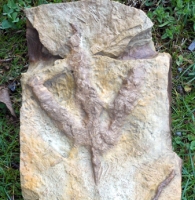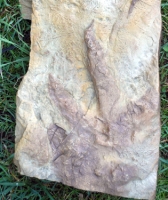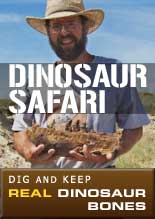
The study of fossilized footprints, Ichnology, has become an important branch of paleontology. Footprints are trace fossils. They are considered trace fossils because they contain no fossil material, only the impressions left by the animal which made them. It is often difficult to determine with certainty which animal made a given print and therefore they are usually attributed to a group rather than a specific animal.
The footprint specimens on this plate are from the Laramie Formation which is below the Denver Formation which occurs just under the K/T boundary. The K/T boundary marks the end of the Cretaceous Period. This would make the footprints approximately 70 million years old. The specimen was found near Golden, Colorado USA. Also included on the specimen are leaves, a root, seeds, and other plant debris giving us a brief look at the paleo-environment.
Footprint specimens from the Front Range area include Theropods ranging from the size of a turkey to Tyrannosaurus, Triceratops, Stegosaurus, Ankylosaurus, Ornithopods, and rarely several species of birds. Ornithopods are known as bird footed dinosaurs. Interestingly though, it is the Theropods and not the Ornithopods that are believed to be the ancestors of today's birds.
Dr. Robert Bakker, a famous paleontologist (author of The Dinosaur Heresies and consultant for the Jurassic Park movies), has studied this specimen briefly. He said that he would need another good track of the other foot to positively rule out the possibility of this track belonging to a bird. In his opinion, the track most likely belonged to an Ornithomimid or an Oviraptorid. Both would have stood about four and a half feet tall. The hallux (big toe) impression at the back of the top foot print may be the result of dragging the middle toe as the step was taken. He also mentioned that if the track did belong to a bird, that it probably would have been a very large heron (about five foot tall). Bird or Theropod, you be the judge. In either case this is a fantastic specimen.
Bird tracks are distinguished from dinosaur tracks by being smaller with widely splayed and slender digit impressions. They also occasionally show a fully reversed hallux; the big toe at the back of the footprint. The first bird tracks from the Mesozoic (age of dinosaurs) were discovered in 1931 by M.G. Mehl near, Golden, Colorado. The tracks were found in the Dakota group, placing them in the Early to Middle Cretaceous (100 to 106 million years ago).
Our specimen is a reproduction of a natural cast. A natural cast is the infilling or overlay of an original impression by sediments. A reverse impression was also made to show what the original impression would have looked like.
The sandstones and shale of the Front Range were an ideal medium for the preservation of dinosaur and other tracks. The Front Range was part of the Cretaceous Western Interior Seaway. This seaway flooded the continental interior from the Gulf of Mexico to the Arctic. Sea level changes and earth movement caused the shorelines to change over time allowing animals to migrate through different areas and in the process leave their footprints for the fossil record. Not all dinosaurs would have visited a shoreline environment and therefore tracks of some are rarely or never found.
Specimen was cast with the permission of Chris Tomkus.
polyresin
18-1/2" x 7" x 2"
Item 2240
MORE PHOTOS:




Now Over 1,000 Items!
PrehistoricStore.com offers the largest selection of replica fossils and other fossil-related products anywhere in the world!
Download a Full Catalog (3MB PDF)
OVER 260 PAGES OF REPLICAS AND MORE!
